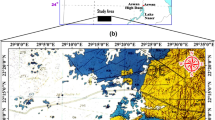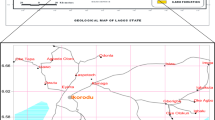Abstract
One of the main factors for the urban sustainable development planning is the fresh water availability, especially in arid area such as Holy Makkah, Saudi Arabia. The area has most important religious places for the Islamic world, and thus, millions of visitors are coming to the city every year. Almost half of fresh water demands in the area are coming from the decreasing groundwater that are embodied in the wadi deposits and fractured crystalline rocks. However, the fresh water demands are rapidly increasing; therefore, the evaluation of the water resources along the area is strongly needed. Integrated geophysical methods to evaluate the subsurface situation and water content have been applied along Wadi Nu’man that is bounding the Holy area. Aeromagnetic and geoelectrical resistivity sounding measurements have been carried out along the wadi. Processing and modeling of the magnetic data indicated that the depth to the basement is irregular and controlled by the subsurface structure elements and the basement topography. The subsurface basement relief model indicated two local basins that undergo to keep the precipitated rainfall. Moreover, processing a suite of 155 vertical electrical soundings (VES) has been carried out along the wadi to determine the varying alluvial thickness covering the subsurface basement and the degree of water saturation. The processing and interpretation of VES data had been controlled by the subsurface lithological information of the available borehole as well as the magnetic data interpretation. Based on the output interpreted models, 2D cross sections have been constructed to emphasize the alluvial wadi deposits and the basement. Finally, the water budget along the wadi has been estimated using the results of geophysical and available metrological data sets. The estimated water stored in the subsurface wadi deposits and shallow fracture basement is around 56 million m3.
















Similar content being viewed by others
References
Abdelkarim, A. and Gaber, A. ED. (2009): Flood risk assessment of the Wadi Nu’man Basin, Mecca, Saudi Arabia (during the period, 1988–2019) based on the integration of geomatics and hydraulic modeling: a case study, Water, 11:1887; doi:https://doi.org/10.3390/w11091887.
Abera W, Formetta G, Brocca L, Rigon R (2017) Modeling the water budget of the Upper Blue Nile basin using the JGrass-New Age model system and satellite data. Hydrol Earth Syst Sci 21:3145–3165
Abu-Rizaiza OS, Sarikaya HZ, Ali Khan MZ (1989) ‘Urban groundwater rise control: case study.’ J. Irrig. and Drain. Engrg. ASCE 115(4):588–607
Alsalah D, Al-Jassim N, Timraz K, Hong P (2015) (2015): Assessing the groundwater quality at a Saudi Arabian agricultural site and the occurrence of opportunistic pathogens on irrigated food produce. Int J Environ Res Public Health 12:12391–12411
Al-Subhi AM (2012) Estimation of evaporation rates in the southern Red Sea based on the AVHRR sea surface temperature data, JKAU: Mar. Sci 23(1):77–89. https://doi.org/10.4197/Mar.23-1.6
Ammar AI, Kruse SE (2016) Resistivity soundings and VLF profiles for siting groundwater wells in a fractured basement aquifer in the Arabian Shield, Saudi Arabia. J Afr Earth Sc 116:56–67
Boubaya D (2017) Combining resistivity and aeromagnetic geophysical surveys for groundwater exploration in the Maghnia Plain of Algeria. Journal of Geological Re-Search. https://doi.org/10.1155/2017/1309053
Brown, G.F.; Jackson, R.O.; Bogue, R.G.; MacLean, W.H. (1963): Geology of the Southern Hijaz quadrangle, Kingdom of Saudi Arabia: Saudi Arabian Dir. Gen. Min. Res. Misc. Geologic Invest. Map I -210A, scale 1:500,000.
Danielsen J, Dahlin T, Owen R, Mangeya P, Auken E (2007) Geophysical and hydrogeologic investigation of groundwater in the Karoo stratigraphic sequence at Sawmills in Northern Matabeleland, Zimbabwe: a case history. Hydrogeol J 15:945–960
Dein, M. A. (1985): Estimation of floods and recharge volumes in wadies Fatimah, Naaman and Turabah, unpublished M.Sc. thesis, Faculty of Earth Sciences, King Abdulaziz University, Saudi Arabia, 127 pp.
GAFS (2019): General Authority for Statistics (stats.gov.sa), Islamic Affairs, Hajj and Umrah, Chapter 16.
Geosoft Oasis Montaj, 2008. Data processing and analysis systems for earth science applications (Ver. 7). Geosoft Inc, Toronto, Canada. www.geosoft.com.
GM-SYS, 2013. Gravity and magnetic modeling software part of the Oasis Montaj Software Suite 7. Geosoft Inc., Toronto, Canada. https://www.geosoft.com.
Gobashy M, Al-Garni M (2008) High resolution ground magnetic survey (HRGM) for determining the optimum location of subsurface dam in Wadi Nu’man. Makkah Al Mukarammah, KSA, JKAU: Earth Sci 19:57–83
Hassanein H, El-Kaliouby H, Al-Garni A (2007) The use of DC-resistivity to outline the subsurface hydrogeological and structural setting beneath a proposed site for subsurface dam building. Makkah Al-Mukarramah, Saudi Arabia, JKAU: Earth Sci. 18:117–138
Healy, R.W., Winter, T.C., LaBaugh, J.W., and Franke, O.L. (2007): Water budgets: foundations for effective water resources and environmental management: U.S. Geological Survey Circular 1308, 90 p.
Kansoh R, Abd-El-Mooty M, Abd-El-Baky R (2020) Computing the water budget components for lakes by using meteorological data. Civil Engineering Journal 6(7):1255–1265
Mashat AS, Basset A (2011) Analysis of rainfall over Saudi Arabia. Journal of King Abdulaziz University-Meteorology Environment and Arid Land Agriculture Sciences 22(2):59–78
Metwaly M, Elawadi E, Moustafa SR, Al Arifi N (2014) Combined inversion of electric resistivity and transient electromagnetic for mapping groundwater contamination plumes in Al Quwy’yia area, Saudi Arabia. Journal of Environmental and Engineering Geophysics (JEEG) 19:45–52
Milsom J, Eriksen A (2011) (2011): Field geophysics, 4th edn. Wiley & Sons, Chichester
Moore, T.A. and Al-Rehaili, M.H. (1989): Explanatory notes to the geologic map of the Makkah quadrangle, sheet 21D. Saudi Arabian Dir. Gen. Min. Res. Geoscience map GM-107C, 1:250,000 scale, Kingdom of Saudi Arabia.
Poulsen TG, Møoldrup P (2005) Factors affecting water balance and percolate production for a landfill in operation. Waste Manage Res 23(1):72–78
Salem, A., Williams, S., Fairhead, J.D., Ravat, D., and Smith, R., 2007, Tilt-depth method—a simple depth estimation method using first-order magnetic derivatives: The Leading Edge, 26:1502–1505.
Sharaf MAM (2013) Trace elements hydrochemistry and suitability of the groundwater in Wadi An Numan area. Makkaah District, Western Arabian Shield, Saudi Arabia, Arab J Sci Eng 38:1871–1887
Spector A., Grant F.S., 1970. Statistical models for interpreting aeromagnetic data. Geophysics 35:293e302.
Talwani, M., Heirtzler, J.R., 1964. Computation of magnetic anomalies caused by two-dimensional bodies of arbitrary shape. In: Parks, G.A. (Ed.), Computers in the mineral industries, Part 1, vol. 9. Stanford Univ. Publ., Geological Sciences, pp. 464e480.
Talwani M., Worzel J.L., Landisman M. 1959. Rapid gravity computations for two dimensional bodies with application to the Mendocino submarine fracture zone. J Geophys Res 64:49e59.
Zaidi S (1983) Landform and geomorphic evolution of Wade Khulais area. Western Saudi Arabia FES Bull 5:153–156
Acknowledgements
The authors would like to thank the Research Supporting Project number (RSP-2021/89), King Saud University, Riyadh, Saudi Arabia for funding this work.
Author information
Authors and Affiliations
Corresponding author
Ethics declarations
Conflict of interest
The authors declare that they have no competing interests.
Additional information
Communicated by Broder J. Merkel.
Rights and permissions
About this article
Cite this article
Metwaly, M., Elawadi, E., Taha, A. et al. Geophysical studies for the aquifer properties along Wadi Nu’man, Holy Makkah area, Saudi Arabia. Arab J Geosci 14, 2316 (2021). https://doi.org/10.1007/s12517-021-08661-4
Received:
Accepted:
Published:
DOI: https://doi.org/10.1007/s12517-021-08661-4




